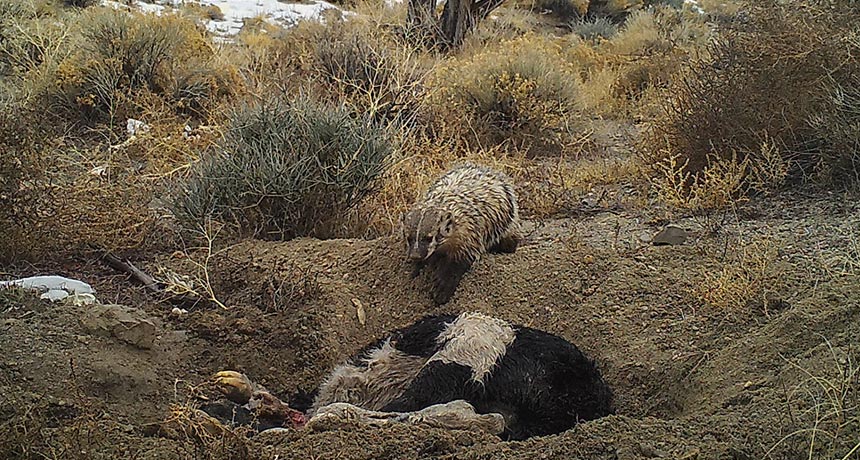Industrious badger caught burying an entire cow
Camera-trap documents the badger digging for days

Badgers are known to bury their meals. Usually it’s small fare, such as jackrabbits. But researchers have now found badgers caching something much bigger — dead calves (like the black and white one here).
COURTESY OF EVAN BUECHLEY
Scientists have caught an industrious badger doing something unexpected. It buried an entire calf.
The American badger is known to bury carrion (dead animals). The cool earth acts something like a natural refrigerator. It keeps food fresh and hides the stored food from potential thieves. But researchers had never spotted badgers burying anything bigger than a jackrabbit — at least, not until 2016. That’s when a young, dead cow went missing. It had been part of a study of scavengers in northwestern Utah.
That January, University of Utah researchers set out seven calves in the Great Basin Desert. Each calf, which had died of natural causes, weighed 18 to 27 kilograms (40 to 60 pounds). A camera trap monitored what happened to these bodies. (Camera traps take a picture or video only when something trips its motion sensor.) After a week, one carcass had disappeared. What made that surprising: All of the calves had been staked in place so that creatures couldn’t drag them off.
But perhaps that hadn’t been enough, the researchers thought. Maybe a coyote or mountain lion managed the feat. To find out, the researchers checked the camera.
Story continues below video.
Its images showed a badger had found the calf on January 16. The next evening, it came back and spent four hours digging below and around the bovine. All that time, it stopped only five minutes to snack on its find.
The badger came back and dug the next afternoon and again the following morning. By that time, it had created a crater into which the calf tumbled. Still, the badger wasn’t done. It spent a couple more days backfilling the hole, to cover its find. It left itself only a small entrance.
For the next few weeks, the badger stayed underground with its meal. It ventured out only briefly. (No one knows where the badger went, but it might have been getting a drink, says Ethan Frehner. He’s the study’s lead author.)
By late February, the badger had moved out. It still came back from time to time. Herds of (living) cows kept coming through the site and these may have disrupted the badger’s dining habits. Although the badger checked on its cache several more times, it never re-entered the burrow after March 6.
This animal’s behavior was not unique. At another carcass site about three kilometers (two miles) away, another badger attempted to bury the calf staked there. But it only got the job partway done. This time, the anchoring stake did its job and prevented a full burial. Instead, the badger dug itself a hole nearby and spent several weeks there feasting on its find.
The calves were three to four times the badgers’ weight. That’s what made the burials so surprising. It was the first time scientists have documented American badgers burying carcasses so much bigger than themselves. The researchers reported their observations this past March 31 in Western North American Naturalist.
“All scavengers play an important ecological role” Frehner says. They help “to recycle nutrients and to remove carrion and disease vectors from the ecosystem.” This study now raises new possibilities about the role of badgers. Those in Utah, at least, might be burying most dead animals they encounter. If they do it throughout their range, they could be responsible for “a significant amount of the scavenging and decomposition process which occurs throughout a large area in western North America,” Frehner says.
What’s more, that burial may not just benefit badgers. It could help ranchers, too. If badgers bury calves that have died of disease, the researchers point out, that could reduce the likelihood a disease will spread. It’s too soon to say whether that happens. However, says study co-author Evan Buechley, this idea “merits further study.”







